4K: evolution or marketing?
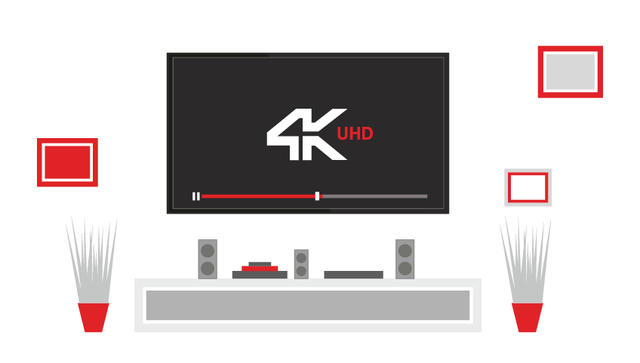
Is 4K destined to become a television standard, or will it remain a privilege available to units? What awaits providers who run the UHD service? In the BROADVISION magazine analysts' report, you will find the answer to these and other questions.
At first glance, it might seem that the quality of a television picture depends on the quantity: the more pixels per square inch, the better. You don’t have to go far for confirmation: remember how enthusiastically the audience accepted the HD and FullHD formats.
However, in the case of 4K, opinions differ: some consider it only a marketing move that hardly improves the user experience; others are boldly called the evolution of the media industry.
An attempt by manufacturers to keep up with the growing demand for ultra-high-definition TVs has already entailed not only the entry into the market of a huge selection of 4K set-top boxes and televisions, but also the emergence of new standards for data compression and transmission, as well as production and storage technologies for 4K content.
Is 4K format destined to become a new technological breakthrough, or will it be fixed in the minds of users as an attempt to make the viewer buy a TV more expensive? Let's see what facts and numbers say about this.
4K TVs: hit coming years
4K TVs are undoubtedly the brightest star in the 4K sky. They are most interested in users and the press. According to OVUM forecasts, the popularity of UHD-TV will only grow. By 2020, the number of ultra-high-definition televisions around the world will exceed 540 million - an almost tenfold increase compared to 2015.
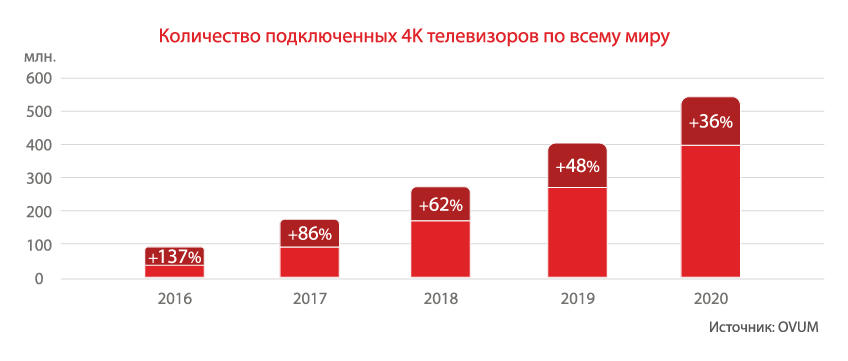
IHS and Strategy Analytics predicts that this year the vast majority of large-diagonal screens (50 inches and above) will support 4K. A bit later, the format will take root in more miniature devices.
This will lead to the fact that by 2020 every fourth family in the world will become the owner of a brand new UHD-TV. Ahead of the planet will be the North American market, where 4K penetration will exceed 45%. In second place is the West European region, the last in this race will be the market of Africa and the Middle East.
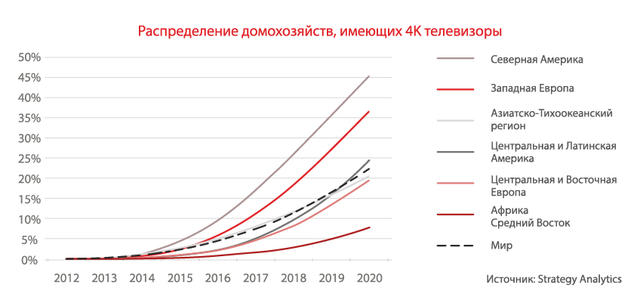
If we talk about individual countries, then the fastest 4K-TV conquer Japan. According to the Mitsubishi Research Institute, by 2020, half of Japanese families will already have UHD TVs.
The real heavyweights in the market of manufacturers of 4K-TVs will be China and South Korea. The largest factories for the production of UHD displays are operating in these countries. The main exporter in this pair will be South Korea, since Chinese manufacturers sell most of the products domestically.
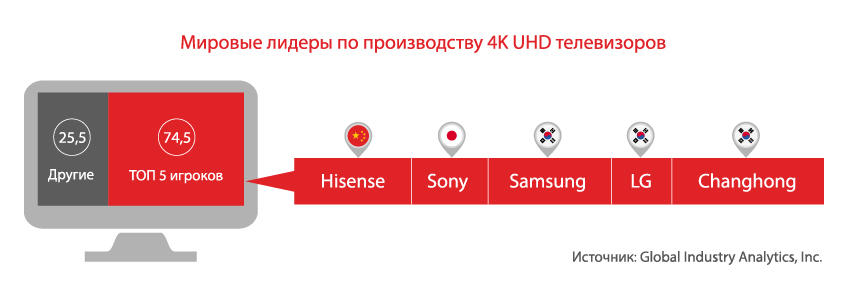
4K set-top boxes: solid market share
Set-top boxing market expects fourfold growth. By 2020, they will make up a quarter of all 4K devices sold.
UHD set-top box sales are growing at 10 million units a year, and it is planned that by 2020 more than 50 million of these devices will be sold.
According to OVUM, by 2020, 4K set-top boxes will be installed in more than 225 million homes worldwide. 80 million viewers from North America and 65 million viewers from Europe and Asia will consume UHD content through the console.
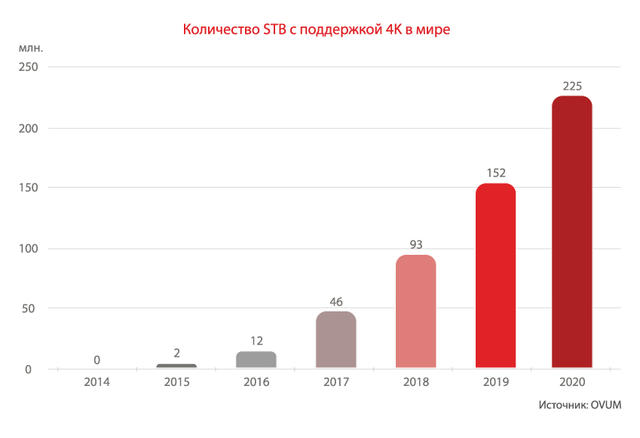
Market services: in the role of catching up
Sales of 4K TVs and set-top boxes are growing steadily. However, their owners have already run into a significant problem: they have nothing to watch. There are several reasons for this:
- Technological: the production of 4K content is complicated and expensive, while the content in FullHD is still popular and pays off well.
- Logistic: not all homes have high-speed Internet.
- Economic: users do not want to buy a subscription, because it is quite expensive, and the choice of content is limited.
Despite all the difficulties, this problem will be solved in the near future. The media industry has already faced a similar situation with the advent of the FullHD format. The owners of new devices then had to wait several years before they had enough content to watch.
The growing selection of videos in UHD, lower prices for TVs, 4K-set-top boxes and subscriptions will steadily lead to explosive growth in the number of users. Most of them will fall on middle and upper class citizens living in the North American, Pacific and Western European regions.
In 2021, a greater number of subscribers will fall on cable, satellite and IPTV broadcasting services. Broadcast TV, with few exceptions, will not be able to offer viewers a UHD resolution.
4K Internet TV
4K-IPTV
Despite the fact that IPTV services still have fewer subscribers than their cable and satellite competitors, IPTV providers will be able to earn more from each viewer individually. The main reason for the spread of profits is that IPTV providers are quickly introducing new popular features into their services, which attracts the most solvent users.

According to OVUM forecasts, by 2021 the number of subscribers of IPTV services with 4K will exceed 10 million. This is more than 20-fold growth compared to 450 thousand in 2017. Most of all, viewers from Western Europe will be connected to such services: in 2021 the number of subscribers in this region will be more than 3 million. They will bring operators $ 1.2 billion in revenue, and this is almost half of the global revenue.
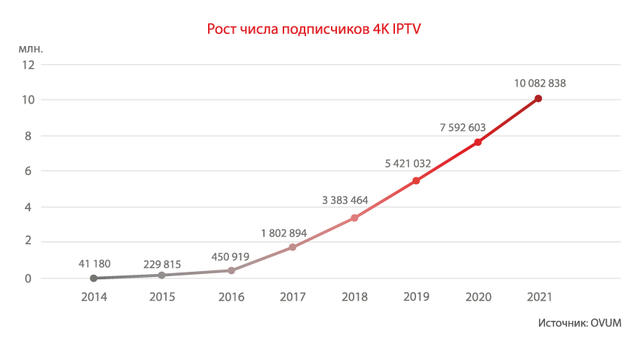
4K-OTT
According to Juniper Research, in the next 5 years, OTT services providing access to 4K content will be especially popular. According to forecasts, by 2021 the number of unique consumers of “over the top” content in 4K will reach 190 million, and the revenue of services will exceed $ 5 billion.
Televisions will remain the main user device for viewing 4K-OTT content, however the widespread introduction of multi-screen technology will make UHD content available on smartphones, tablets and desktops.
To summarize

We can safely say that 4K content will not take long, and its popularity will only grow. But let's look at the main factors that affect the speed of technology adoption:
Growth factors.
- Demand for High-End Electronics.
- The emergence of new UHD channels and services.
- Cheaper 4K equipment.
- The development of compression algorithms and data transfer technologies.
Restraining factors.
- While UHD equipment is still not affordable for the majority of the population.
- As the market is just emerging, not all investors risk investing in it.
- Creating 4K content is several times more expensive than creating FullHD.
- The network infrastructure necessary for transmitting 4K video is not developed.
- Residents of remote or small settlements do not have access to high-speed Internet, 4K content will not be available to them for a long time.
Already now the operators have a difficult choice: to create their own 4K-service, while there is no competition, and demand is growing steadily; or focus on FullHD until the networks of their viewers are ready for 4K broadcasting.
High-quality images are not enough to win the love of users. Content should be interesting. This is confirmed by the shows that were shot on the smartphone’s camera, but were able to win millions of audiences.
